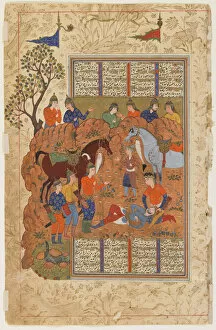Nastaliq Script Collection
The Nastaliq script, known for its elegant and flowing style, has been an integral part of Persian calligraphy for centuries
All Professionally Made to Order for Quick Shipping
The Nastaliq script, known for its elegant and flowing style, has been an integral part of Persian calligraphy for centuries. Its beauty is exemplified in various artworks throughout history. In one depiction, Rustam's strength shines as he kicks back the rock rolled on him by Bahman from a Shahnama (Book of Kings). The intricate curves and delicate strokes of the Nastaliq script mirror the grace with which Rustam overcomes adversity. Another artwork showcases Kai Khusrau Enthroned Holding a Sword, created between 1300-30. Here, the Nastaliq script adds depth to the regal scene, enhancing the grandeur of Kai Khusrau's presence. Emperor Babur's detached album folio from the late 19th century features opaque watercolor and highlights his love for calligraphy. The inclusion in this piece demonstrates his appreciation for both art forms. A page of calligraphy from a 17th-century detached album folio captures attention with its intricate details. The gold accents intertwined with ink showcase how they are elevate any composition to new heights. Kay Khusraw installing Luhrasp as king in an artwork from 1493-94 portrays not only their historical significance but also showcases the artistic prowess behind each stroke used to depict their story. Zal climbing to reach Rudaba from a Shahnama (Book of Kings) illustrates another captivating tale brought to life through artistry and skillful use of Nastaliq script. Each curve and loop tells a story within itself. The arrival of Khanan's daughter at Nushirwan's palace in another Shahnama painting exhibits how even mundane events are transformed into something extraordinary when combined with beautifully written Nastaliq text. Iskandar comforting Darab during his final moments depicts compassion amidst tragedy.













































